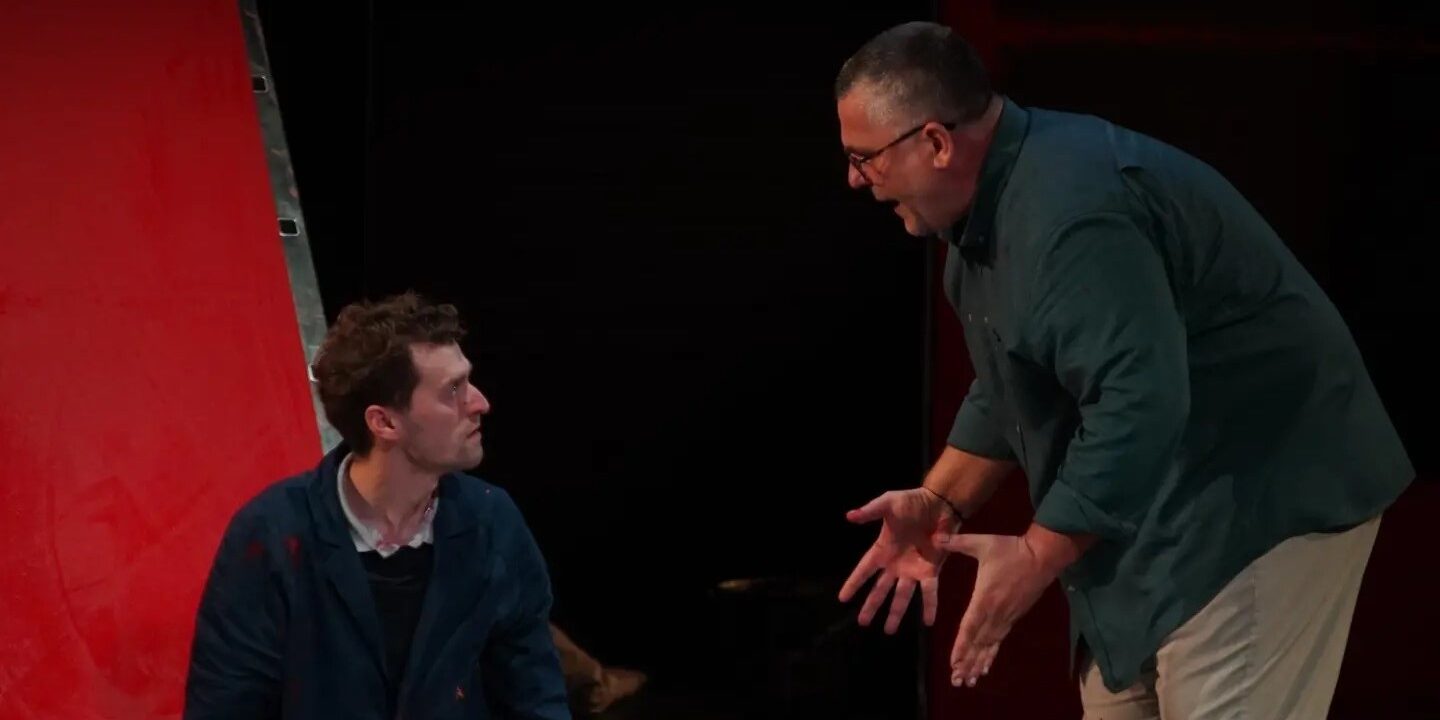National Experimental Theater “Kujtim Spahivogli”, Tirana, premiere 15th November 2023
There is “tragedy in every brush stroke.” This was the expression used by Mark Rothko to articulate his internal conflict as a painter, but it also captured the whole story. In John Logan’s play Red, art is like a portal that the soul uses to reveal its troubles, something which is further explored through the relationship between Rothko (Gentian Zenela), one of the most preminant of the Abstract Expressionist painters, and Ken (Urim Aliaj), his assistant, a young man who wanted to become a famous painter in the future.
Logan’s bio-play, which was produced for the first time in 2009 at the Donmar Warehouse, London, showed how a two-hander play can highlight this potent clash between generations and opinions, in relation to art. Set in the late 1950s and inspired by real events, the play shows how Ken, an aspiring painter comes to work as Rothko’s’ assistant. Though it never openly shows which style Ken belongs to,it is implied that he enjoys pop art and this ignites the main conflict between him and his employer, who expresses constant disdain for pop art, underestimating it and its buyers.
Rothko is afraid that his art, which he “brings to life” with such care and pain, will one day be replaced. His greatest fear is that “one day the black will swallow the red”, an indicator of his inner suffering, and an expression not just of his fear of being replaceable (the red, present in all his paintings, would be overtaken by black, nothingness), but that he could also one day disappear.
In this respect Rothko mentions painters who have died by suicide such as Jackson Pollock; according to Rothko, art is so great that it is worth dying for. He talks about Nietzsche, Freud, Jung and Shakespeare, and feels that only those with such intellect and knowledge one can understand his art. Ken brings him down to earth and reminds him that the paintings he is working on are just for a luxury restaurant, ironically named “Four seasons” for the Vivaldi symphony. No one there will see his art as a temple, even though Rothko lies to himself that this will happen.

Red – National Experimental Theater “Kujtim Spahivogli”
As Rothko, Zenelaj gives a powerful performance, in the sense that he made the artist appear convincingly aggressive and arrogant, but sometimes he also made the character more understanding than I think he should have been; the barriers that Rothko placed between himself and people needed to be more clearly felt. I also felt that the character of Ken, as played by Aliaj, felt more alive and tangible. The audience could feel that Ken had no one in this world but himself.
The relationship between the actors on stage was strong, for the most part, and there was an emotional communication between them, but I felt that the fluctuations in their relationship were missing. Their exchanges felt too uniform, while more of an extreme change between the performers should have been evident given that they were supposed to gradually develop a father-son relationship. While the disrespect that Rothko has towards Ken and his peers should be felt to begin with, this situation would change over time.
There were abstract red paintings spread all over the stage, drawing us even further into Rothko’s isolated world, but I would have liked to see the actors interact with them more. In the powerful monologue in which Rothko expresses his fear that no one would carefully notice his paintings in the fancy restaurant and his disgust of people’s poor consideration about art, Zenelaj addressed his words to the audience, whilei it seemed to me that he was really addressing the paintings, given that the compelling central conflict of the play was between the artist and his creations. Again, when Ken talks about his past traumas, he also addresses the audience, when it feels like it should have been an intimate moment between him and Rothko.
Director Altin Basha has staged Logan’s play in a very impressive way, from the scenography (by Iliriana Loxha Basha) to the portrayal of the characters. Visually, the show looks like a mosaic, composed of different shades of red. But, considering the major questions explored by the work, such as: whether society has lost the sense of perceiving whether or not something valuable, the argument raised by Rothko that “people should distinguish between what one likes and what really has value and meaning to them”, it feels like, in order to elaborate on this in greater depth – since the embrace of commercial art by the public remains a very current problem – the production would have benefited from a more creative directorial treatment.
The use of colour as the personification of trauma and of human characters was powerfully displayed and skilfully deployed, from the juxtaposition of Apollonian and Dionysian impulses in Rothko’s paintings to the juxtaposition of the red and black. The colour white also brings back painful memories for Ken, memories of the death of his parents. It was snowing outside when it happened and white transports him, but Ken is not afraid of the white, unlike Rothko, who clings to the red, with the hope that it would rekindle a light in the darkness for him.
One of the other interesting aspects of the play was the way it showed how the balance of opposites within us was impossible and human psychosis is more complicated than that, but a stronger message triumphed – that “art protects the truth from disappearing” and that an artist has the opportunity to create this profound portal, to exhibit his psyche, and that this is something that can lead to salvation.
Credits:








